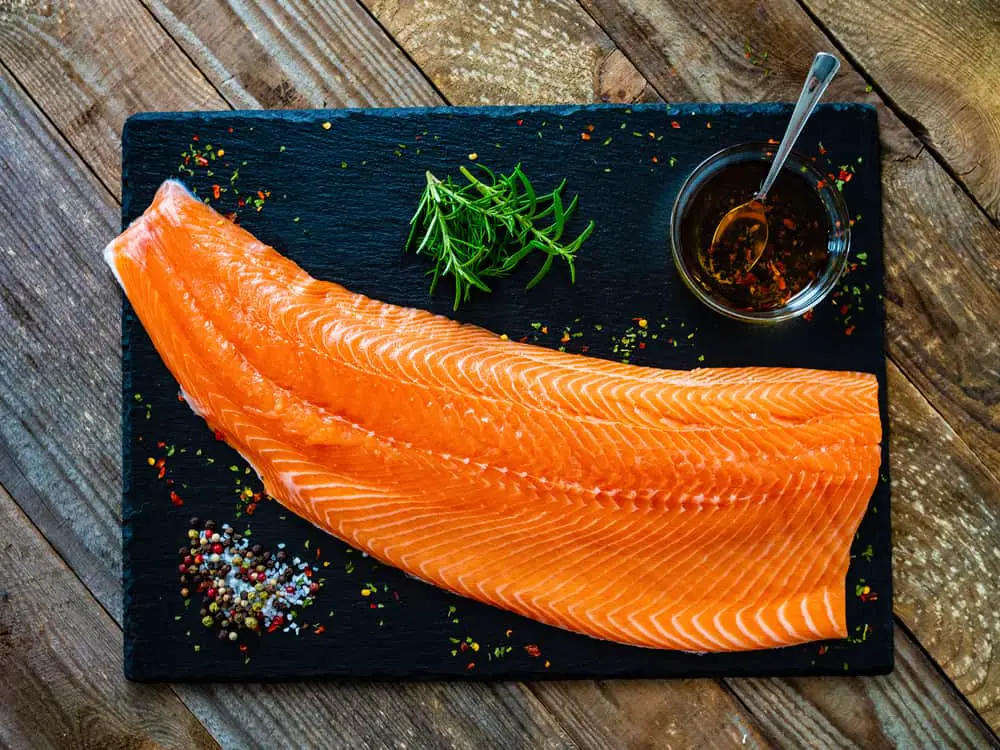Last Updated on 20th July 2023 by
Salmon is an all-time favourite because it’s tender, delicately flavoured, and surprisingly easy to make. The only downside is that it’s quite expensive! This is why it’s imperative to know how to prepare raw salmon for cooking, so what arrives at the dinner table is worth the spend.
In this article, you’ll find everything you need to know when preparing raw salmon!
Table of Contents
The Best Way to Prepare Raw Salmon
There are multiple ways on how to prepare salmon. Some like eating it raw, similar to what you’d find in sushi, while others like it steamed, fried, or cooked in the oven. To get the perfect slice of salmon, here are some steps you need to follow.
Step 1: Grab a Sharp Knife
Salmon is delicate, which is why you need to prepare it with utmost care. Before I started preparing and cooking seafood professionally, I used to grab any ol’ knife I had available.
Although it gets the job done, there’s a high chance it might damage your fish. As such, it’s best to use a fillet or a salmon knife when preparing salmon.
Fillet knives have specific characteristics that make cutting salmon a walk in the park. This type of knife typically has a long, robust blade that offers excellent control when cutting fish. Most importantly, it allows you to easily cut along the backbone and under the skin of the salmon so no part of it is wasted.
The same can be said for salmon knives. This knife is used to cut and serve especially thin slices of salmon. Its blade is so sharp that it glides through the delicate flesh of the salmon without ripping or tearing it.
Step 2: Remove the Belly Fat
The belly fat is the thinnest side of the fish which tends to be lighter in colour and, you guessed it, fattier than the rest of the fish. A salmon’s belly fat is often removed during preparation because it has a different texture than the rest of the salmon. Plus, if left on the salmon, the fish won’t cook evenly.
Once you remove the belly fat, keep it aside to cook for later. Don’t throw it away! Salmon belly is extremely flavourful and comes packed with omega-3 because of its fat content.
Step 3: Trim Away the Skin and Bones
Depending on the size and sharpness of your knife, you can remove it from each fillet one at a time or remove it from the whole side at once. Taking off the skin all at once is usually more time-efficient, but only if your knife is long and sharp enough for the job.
Here’s how to remove skin from salmon: with individual fillets, start removing it from the belly side of the fillet and work towards the other side by making a cut between the flesh and skin. When it comes to whole cuts, start at the tail and work towards the head.
For both instances, make a hole large enough so you can stick your finger through. This is what you will hold onto while you skin the rest of the fish. Once you have a good grip, move your knife away from the grip and slice gently. Remember to keep the blade parallel and as close as possible to the cutting board.
While cutting, you might find some darker flesh underneath the skin. Since it’s typically found on the underside of the fillet, no one will see it. You can leave it on as it’s full of natural oils and omega-3. Once you’ve removed the skin, you can safely debone the fish of its ribs and pin bones.
Step 4: Cut the Salmon
Once you’ve removed the skin, you can now decide what size and shape you’d like to cut your salmon. If you prefer an easier to manage shape in the kitchen, slice the salmon into wider portions and then cut them in half to form squares. If you want them skinny and straight, slice straight across the fillet.
How to Fillet a Salmon
FAQs
How To Debone Salmon?
Deboning a salmon is fairly easy. First, lay the fillet with the skin side down on the cutting board and insert your knife underneath the first few sets of ribs. Discard the flap once you’ve removed it. Don’t cut too deeply or you’ll lose too much of that tasty meat.
Then, extract the remaining small pin bones with needle-nosed pliers. Don’t forget to remove the centre bone, as well.
Why Is Salmon Good For You?
There are multiple benefits found in salmon. Firstly, it’s rich in a protective antioxidant called astaxanthin, which is used to help prevent and treat various cancers and heart diseases.
It’s also an excellent source of potassium and selenium, along with vitamin B12 and natural omega-3 fatty acids.
Which Salmon Is The Healthiest?
Wild Pacific salmon is widely considered to be the healthiest because it contains more minerals than farmed salmon, including potassium, zinc, and iron. However, farmed salmon has a higher fat content because they’re fed a diet that includes grains and vegetable oils high in omega-6 fats.
Therefore, while wild salmon has a higher nutritional value, any type of salmon is still a healthy food.
How To Freeze Salmon?
Freezing raw salmon is fairly straightforward. After rinsing and patting it dry, tightly wrap it in a plastic wrap. Then, place it in an airtight container or a zip-lock bag. Make sure to use the salmon within 3 months of you storing it in the freezer.
What To Do With Smoked Salmon?
There are infinite possibilities when it comes to smoked salmon. For breakfast, you can serve it on top of toast beside a bed of scrambled eggs and avocado. You can also use it in salads, sushi, pasta, and even as a sandwich filler.
How Much Salmon Per Person?
3 to 4 ounces of salmon per person is considered a healthy serving size. According to the Harvard T.H. Chan School of Public Health, the recommended consumption of low-mercury seafood like salmon is 12 ounces every week.
Final Thoughts
The salmon industry has grown massively over recent decades, so what once has been a rare delicacy, only served in the highest restaurants and dinner tables, is now considered a staple in many of our shopping lists.
Preparing salmon isn’t as difficult as it may initially seem. With a bit of practice, you’ll be able to prepare salmon even with your eyes closed. Happy eating!
I'm Pauline, a mother of four grown children, my passion for cooking stemmed from the joy i get cooking for my family. I love to try new dishes, especially when dining out but creating and sharing my own recipes is my favourite thing to do!



shrink
Friday 21st of February 2025
CHNZpHu9ZFZ
20bet
Wednesday 13th of September 2023
Your article gave me a lot of inspiration, I hope you can explain your point of view in more detail, because I have some doubts, thank you.